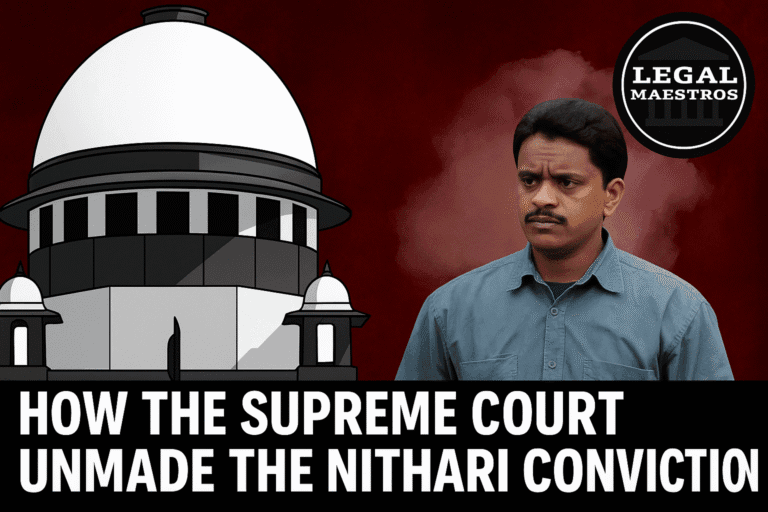
Supreme Court Bench of Justices Sudhanshu Dhulia and K. Vinod Chandran Clarifies Deduction of Government Assistance in Motor Accident Compensation
Introduction
The Supreme Court of India rendered a significant ruling in the matter of *New India Assurance Co. Ltd. vs. Sunita Sharma and Others* on April 8, 2025. This case concerned the question of whether compensation received under the *Haryana Compassionate Assistance to the Dependents of Deceased Government Employees Rules, 2006* (usually known as the Rules of 2006) should be deducted when computing compensation under the *Motor Vehicles Act, 1988*. The Court’s verdict underlined the continuous dispute in High Court decisions and confirmed the power of Supreme Court precedents under Article 141 of the Indian Constitution.
Background and Synopsis of Facts
The case started with a Motor Vehicles Act, 1988 road accident claim underlined under The departed worked for the government of Haryana. The legal heirs of his accidental death claimed compensation against New India Assurance Company. Compensation was given by the Motor Accidents Claims Tribunal (MACT), later partially altered by the High Court. The High Court subtracted from the total compensation just half of the money the claimants had received under the Rules of 2006. The insurance company contested this arrangement, contending that to prevent duplication of benefits, the whole amount earned under the 2006 Rules should have been subtracted.
Though it had already accepted the Supreme Court’s binding decision in *Reliance General Insurance Co. LTD. v. Shashi Sharma*, the High Court defended its decision by basing it on its own past ruling in *Kamla Devi v. Sahib Singh & Ors*. This paradox became a major concern before the Supreme Court.
For any queries or to publish an article or post or advertisement on our platform, do call at +91 6377460764 or email us at contact@legalmaestros.com.
Important Legal Provisions Reviewed
In this case the Supreme Court examined the implementation of two main statutes: the *Rules of 2006* and the *Motor Vehicles Act, 1988*.
Compensation under the automobile Vehicles Act is supposed to be “just” and guarantee that victims or their families are fairly paid for the loss brought about by an automobile accident. Section 168 of the Act lets the Claims Tribunal decide, depending on case facts, the compensation sum that seems fair.
Conversely, the 2006 Rules of Special State Government are unique laws meant to give families of government workers financial assistance upon death while in service. Along with other benefits including pension, insurance, and provident fund, the regulations call for paying financial assistance equal to the last received salary of the dead employee. These compensation, however, apply even in cases of natural death and are not contingent on the reason of death.
For any queries or to publish an article or post or advertisement on our platform, do call at +91 6377460764 or email us at contact@legalmaestros.com.
For More Updates & Regular Notes Join Our Whats App Group (https://chat.whatsapp.com/DkucckgAEJbCtXwXr2yIt0) and Telegram Group ( https://t.me/legalmaestroeducators )
the primary legal issue
The main question before the Supreme Court was whether the compensation given under the Motor Vehicles Act should be removed from the financial help given under the Rules of 2006, particularly the component linked to pay and allowances, therefore avoiding the same benefit being paid twice.
In the case of *Shashi Sharma (2016) 9 SCC 627*, the Supreme Court has already decided by a three-judge bench this matter. In that ruling, the Court decided that the compensation given under the Motor Vehicles Act had to be removed from the financial aid obtained under the Rules of 2006—more especially, the wage equivalent component—to prevent unfair enrichment. The Court underlined that “just compensation” does not imply repeated payment from several sources for the same loss.
For any queries or to publish an article or post or advertisement on our platform, do call at +91 6377460764 or email us at contact@legalmaestros.com.
The Reasoning of the Court and Reference to Precedents
The Supreme Court in its thorough ruling not only cited the *Shashi Sharma* case but also the more recent ruling in *National Insurance Co. Ltd. v. Birender and Others*, where the same concept was used. The Court decided in *Birender* that the compensation under the Motor Vehicles Act must be subtracted from any sum claimed under the Rules of 2006 or expected to be received. It was also underlined that these deductions apply only to salary-related remuneration and not to other benefits as provident fund, pension, or insurance.
The Court underlined once more that, independent of the manner the death happened, the financial aid given under the Rules of 2006 was a benefit conferred by the employer in case of death during service. Under the Motor Vehicles Act, on the other hand, compensation is meant to cover erroneous death resulting from an accident brought on by negligence. Although both have different uses but affect the financial outcome, a reasonable adjustment is needed to prevent double recovery.
Article 141 Violationand Supreme Court Displeasure
The Supreme Court’s main focus was on the High Court’s decision to follow its own earlier ruling in *Kamla Devi*, which went against their perspective even if they acknowledged the precedent set in *Shashi Sharma*. Pointing out that the law decided by the Supreme Court is legally obligatory on all courts in India under Article 141 of the Constitution of India, the highest court sharply disapproved of this approach. The judges voiced astonishment and dismay at the High Court’s rejection of legally enforced precedent in favor of its own past interpretation.
For any queries or to publish an article or post or advertisement on our platform, do call at +91 6377460764 or email us at contact@legalmaestros.com.
Last Choice and Guidance
The Supreme Court let New India Assurance Company to appeal. It threw aside the High Court’s ruling to the degree that it had deducted just half of the compensation obtained under the 2006 Rules. It said that the compensation paid under the Motor Vehicles Act was to be subtracted from the whole amount obtained under the Rules for salary-related financial support. The Court showed sympathy, nevertheless, by ruling that no recovery should be sought from the claimants should the entire sum have already been paid to them.
This harmony guaranteed not only respect of legal values but also protection of the recipients from financial difficulty.
Summary and Value
For compensation cases involving dead government employees, this ruling has significant ramifications. It offers unambiguous direction on how courts should manage conflicting benefits under several legislation. The Supreme Court’s ruling makes clear that although family members are entitled to several kinds of compensation, they cannot be let to get the same advantage again under different titles.
For any queries or to publish an article or post or advertisement on our platform, do call at +91 6377460764 or email us at contact@legalmaestros.com.
The ruling enhances legal consistency and justice by maintaining the idea of just compensation and underlining the binding character of Supreme Court rulings. It also emphasizes to lesser courts and High Courts that they have to strictly adopt rulings of the supreme court without exception.


![JOB POST: Junior Associate at ASM Law Chambers, Jaipur [Freshers]](https://legalmaestros.com/wp-content/uploads/2025/11/Gemini_Generated_Image_8wrxer8wrxer8wrx-768x708.png)


